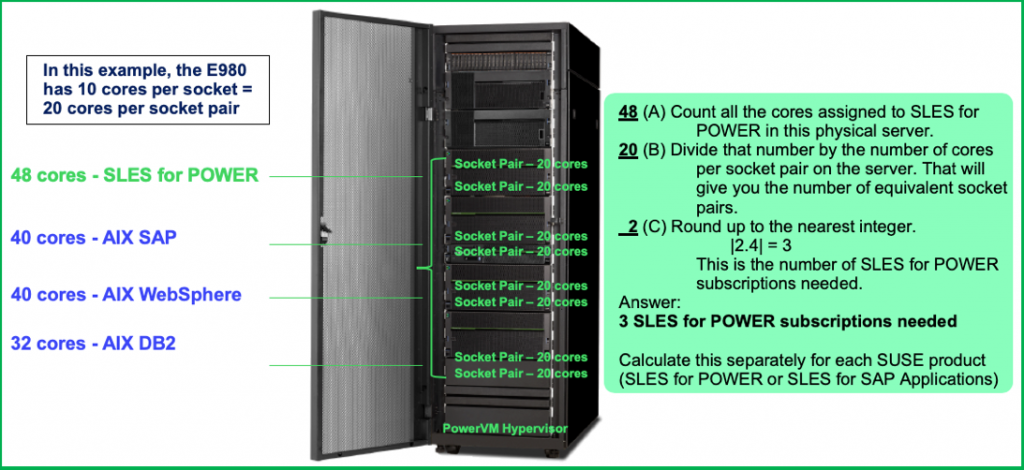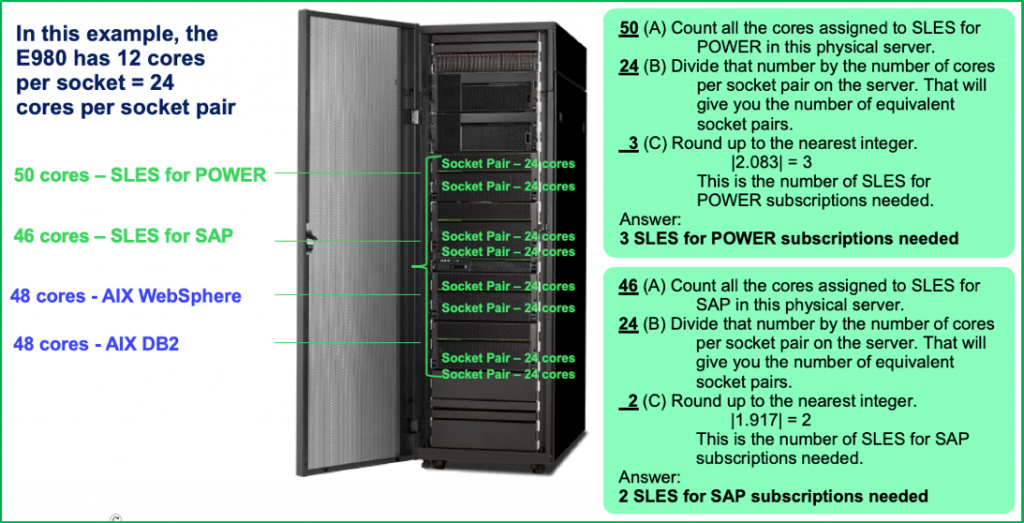Understanding SUSE Sub-capacity pricing for IBM Power servers

Executive Summary
SUSE recently updated Terms and Conditions for SUSE products to clarify the SUSE pricing policies for IBM Power systems and to accommodate Sub-capacity pricing on IBM Power servers.
Sub-capacity pricing overview
IBM Power servers have long been known for vertical scalability (up to 192 cores and 64TB of RAM) and for efficient PowerVM virtualization infrastructure. As a result, many customers use IBM Power servers to consolidate multiple workloads on a single server.
PowerVM virtualization can guarantee that a particular workload can only run on a subset of the processors on a particular system. For example, you could have a 192 core IBM Power server with 32 cores running a DB2 database with AIX and the other 160 cores could be running SAP HANA on SUSE Linux for SAP Applications.
Software subscriptions traditionally have been priced based on the amount of CPU capacity available to run the software, fewer cores generally mean lower software cost. This is known as Sub-capacity pricing because the customer is only paying for software based on a subset of the total hardware capacity.
Most IBM software is sold based on Sub-capacity pricing, so IBM Power customers expect to pay for software licenses or subscriptions based on the amount of processor capacity available to each workload.
Sub-capacity pricing for SUSE products on IBM Power
SUSE products started on X86 servers, where prices were traditionally based on the number of processor sockets as a measure of CPU capacity. Server consolidation is less prevalent in the X86 market and Sub-capacity pricing for software is less common. As a result, the price of most SUSE subscriptions is based on the number of processor sockets available in the server, known as Full-capacity pricing.
In view of the unique capabilities of the IBM Power platform, we have changed the Terms and Conditions for SUSE product subscriptions to accommodate Sub-capacity pricing on Power. This will allow customers to partition their IBM Power servers with PowerVM virtualization and only pay for the capacity available to that SUSE product on a particular server.
The charge metric of SUSE product subscriptions on IBM Power has not been changed and is still measured in “socket pairs”. Because IBM PowerVM allocates processor capacity in terms of processor cores, there needs to be a way to convert the “cores” allocation in PowerVM to the equivalent number of socket pairs for SUSE subscription purposes.
Because SUSE subscriptions are sold in increments of socket pairs, to use Sub-capacity pricing on Power while still using socket pairs, you need to calculate the Socket Pair Equivalent that represents the CPU capacity that is made available to the SUSE workload.
Unfortunately, there is another complication in that IBM Power servers have different numbers of cores per socket, and thus per socket pair. For example, an IBM E980 server with hardware feature #EFP1 has 8 cores per socket, or 16 cores per socket pair. The same hardware ordered with feature #EFP3 has 12 cores per socket or 24 cores per socket pair. You must know the number of cores per socket in the server before you can calculate the Socket Pair Equivalent for SUSE subscription purposes. The number of cores per socket on an IBM Power server is tied to the processor speed. Faster speed = Fewer cores per socket.

Conditions for using Sub-capacity pricing for SUSE products on IBM Power
- The SUSE product must use socket pairs as the charge metric.
- SUSE Linux Enterprise Server (SLES) for Power, SLES for SAP Applications on Power, SUSE Manager Server for Power and SUSE Manager Lifecycle for Power are all included.
- This is only applicable to POWER8 and POWER9 (and later generations) with four or more sockets.
- E850, E880, E870, E950, and E980 are all eligible for Sub-capacity pricing.
- PowerVM virtualization must be used to restrict the amount of capacity available to the SUSE products being used
- Acceptable methodologies: Dedicated processor partitions (Dedicated LPAR), Dynamic LPAR, Single or Multiple Shared Processor Pools
- Refer to the IBM standard on Sub-capacity pricing: https://www.ibm.com/software/passportadvantage/subcaplicensing.html
- The Integrated Facility for Linux (IFL) processors does not automatically limit Linux workloads to only run on IFL processors and are not relevant to Sub-capacity pricing.
- Customers and Sellers must account for the different number of cores per socket when calculating the Socket Pair Equivalent
- Number of cores available to SUSE Linux ÷ by the number of cores per socket = Socket Pair Equivalent
- Round up to nearest socket pair
- The customer must purchase subscriptions for the maximum number of socket pairs that are ever available to run SUSE workloads.
- Customer is responsible for purchasing additional subscriptions if the processor capacity is increased through changes to pools or activation of dark processors or other changes to the server capacity.
Example 1: Calculating Socket Pair Equivalent for IBM Power E950
In this example, the E950 has 10 cores per socket = 20 cores per socket pair.
Example 2: Calculating Socket Pair Equivalent for IBM Power E950 with Rounding
In this example, the E950 has 10 cores per socket = 20 cores per socket pair.

You can see that if the calculations end up with a fractional value, (that is, the number of cores is not an integer number of sockets) you must round up to the next nearest integer.
Example 3: Calculating Socket Pair Equivalent for IBM Power E950 lower core count and rounding
In this example, the E950 has 8 cores per socket = 16 cores per socket pair.

As in the previous example, you can see that if the calculations end up with a fractional value, (that is, the number of cores is not an integer number of sockets) you must round up to the next nearest integer.
Example 4: Calculating Socket Pair Equivalent for IBM Power E950 with Dynamic LPAR
In this example, the E950 has 10 cores per socket = 20 cores per socket pair and the system administrator is using Dynamic LPAR (DLPAR) to dynamically change the number of cores available to SLES for SAP.

Before the DLPAR operation, the SLES for SAP LPAR/VM had 18 cores of capacity which would round up to 1 socket pair of capacity but after the DLPAR operation, the SLES for SAP LPAR/VM is over 2 sockets of capacity and thus requires 2 SLES for SAP subscriptions.
The customer must provide enough SUSE subscriptions to cover the maximum capacity ever used.
Example 5: Calculating Socket Pair Equivalent for IBM Power E980 Server Consolidation
In this example, the E980 has 10 cores per socket = 20 cores per socket pair.

Once again, we see that if the number of cores assigned to the SUSE product is more than 2 socket pairs, so 3 SLES for Power subscriptions are needed for this configuration.
Example 6: Calculating Socket Pair Equivalent for IBM Power E980 with multiple SUSE products
In this example, the E980 has 12 cores per socket = 24 cores per socket pair.

There are two different SUSE products installed on this system. The Socket Pair Equivalent calculation must be performed for each SUSE product installed on a physical server.
Summary
Server consolidation is a common practice for IBM Power servers and Sub-capacity pricing is important to supporting consolidation. Using the Socket Pair Equivalent approach allows customers to leverage Sub-capacity pricing for SUSE products on IBM Power servers and to leverage the capabilities of PowerVM while maintaining compliance with SUSE terms and conditions.
Reference: Cores / Socket for IBM POWER9 Enterprise servers

Reference: Cores / Socket for IBM POWER8 Enterprise servers

Related Articles
Jul 05th, 2022
SUSE Rancher removes roadblocks to transformation
Jul 25th, 2022

Comments
Excellent blog with really good examples to support the theme.
Great blog that covers off the socket side of the equation nicely. Please include detail on the VM quantity side to the license equation. For example if running 3 VM’s of SLES SAP on a 8 socket E880 would the license be for 4 x 1-2 Socket, 1-2 VM’s SLES for SAP …. or would a 4 x 1-2 Socket, unlimited VM’s SLES for SAP license be required?